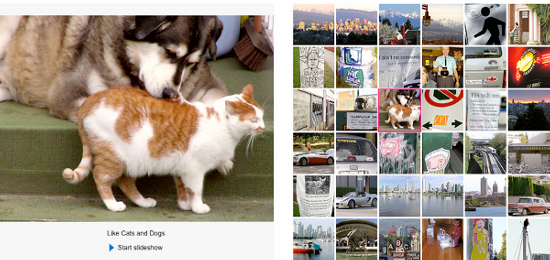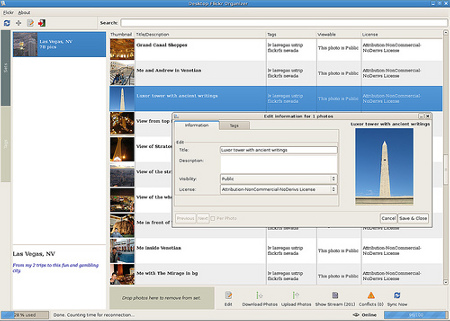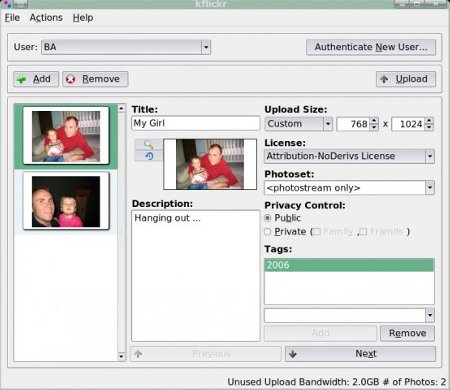The Flickr photo-sharing Web site is popular not just for its social networking features, but because it makes its APIs available to outside software developers so it can be integrated into other applications. On Linux, several popular photography and graphics applications support Flickr, and there are special-purpose Flickr applications to choose from, too.
On the Web
There are several open source plugins for the Firefox browser that make using the Flickr Web site easier. Fireflix and FlickrFox each add a sidebar to your browser window with photo uploading, management, and search controls. Flickr Gallery Plus adds features to Flickr galleries, allowing you to more easily navigate between pictures with the mouse or keyboard. Better Flickr is a set of Greasemonkey scripts with which you can add functionality to several part of the site: replying to comments, magnifying individual photos, and showing extra information on photo thumbnails and page menus. In addition, there are plenty of Firefox extensions that support specialty tasks using Flickr as a back-end, such as slideshow generation. You can find them all in the Photos, Music and Videos section of addons.mozilla.org.
Uploading to Flickr
 Flickr support is also built in to the major Linux desktop photo management applications. Digikam and F-Spot can export selected photos to Flickr directly, saving you the intermediate step of saving an edit copy to disk, only to upload it via the Web browser. Picasa can export to Flickr with the addition of the picasa2flickr plugin. Beyond these “big three” applications, many other Linux photo management applications either have native Flickr support or can provide it with a plugin.
Flickr support is also built in to the major Linux desktop photo management applications. Digikam and F-Spot can export selected photos to Flickr directly, saving you the intermediate step of saving an edit copy to disk, only to upload it via the Web browser. Picasa can export to Flickr with the addition of the picasa2flickr plugin. Beyond these “big three” applications, many other Linux photo management applications either have native Flickr support or can provide it with a plugin.
 If you don’t use any of the above applications, or if you need to upload images to Flickr that you create elsewhere (such as in GIMP, Krita, or Inkscape), a stand-alone Flickr uploader may better suit your workflow. The mostly widely-used Flickr upload tools are Desktop Flickr Organizer (DFO), jUploadr, and KFlickr. jUploader is a Java program, so you will need a Java runtime in order to use it. DFO is a GTK+ application that integrates well with the GNOME desktop, and KFlickr is meant to fit in with KDE. All allow you to upload your photos directly from your computer to Flickr, with control over titles, descriptions, privacy, and tags. They differ slightly in the features supported–KFlickr supports connecting to multiple Flickr user accounts, for example, while DFO supports remotely editing and deleting photos from the Flickr account–so check out each to see if a particular feature stands out to meet your needs.
If you don’t use any of the above applications, or if you need to upload images to Flickr that you create elsewhere (such as in GIMP, Krita, or Inkscape), a stand-alone Flickr uploader may better suit your workflow. The mostly widely-used Flickr upload tools are Desktop Flickr Organizer (DFO), jUploadr, and KFlickr. jUploader is a Java program, so you will need a Java runtime in order to use it. DFO is a GTK+ application that integrates well with the GNOME desktop, and KFlickr is meant to fit in with KDE. All allow you to upload your photos directly from your computer to Flickr, with control over titles, descriptions, privacy, and tags. They differ slightly in the features supported–KFlickr supports connecting to multiple Flickr user accounts, for example, while DFO supports remotely editing and deleting photos from the Flickr account–so check out each to see if a particular feature stands out to meet your needs.
Other options are available, though, such as the command-line Perl uploader flickr_upload, or the lightweight, Python-based Kphotobymail and Postr, which are built for KDE and GNOME desktops, respectively.
Downloading from Flickr
Uploading your content to Flickr is only half the fun; storing your images on Flickr for safekeeping and exploring images from your friends (or searching for unique content) are possible from the desktop, too. Since Flickr makes it easy to tag content with Creative Commons licenses, the site is also a good source of free, share-able stock photography for presentations, desktop wallpaper, or slideshows.
FlickrEdit is the most full-featured download tool; it is a Java application that started out under the name FlickrBackup, designed to quickly download your entire Flickr photo archive. The new program does more, including metadata editing and support for sets, favorites, and groups. FlickrGettr is a lighter, more streamlined alternative written in Perl, and that can be used from the command line, with a graphical interface, or run as a CGI Web application.
Webilder and Wally are both utilities designed to grab images from Flickr and use them as your background wallpaper. Both work with KDE and GNOME, as well as other Linux desktop environments. With these applications, you are not limited to just your own photos: you can automatically search for keywords in descriptions and tags to find interesting photos from any user on Flickr. If you use KDE 4.0 or later, you can also try out the Flickr On Plasma widget, which runs a slideshow of Flickr photos tagged as “interesting.”
Finally, the ultimate integration between Flickr and the Linux desktop is flickrfs, a filesystem module for FUSE. Flickrfs links Flickr content directly into your computer’s filesystem, so that your remote photos appear to be local files to all of the applications on your computer.
Flickrfs’s primary use case is to give you seamless access to your photos from every application you use–file manager, image editor, even command-line script. It can synchronize your Flickr photos with local directories, and automatically creates a sets directory so that you can move images into and out of sets easily.
It also creates a tags directory, with personal and public subdirectories beneath it. The tags/personal/ directory allows you to search for photos using each of your tags, but the tags/public directory searches across Flickr. To make a search, you simply create a folder inside tags/public or tags/personal with the name of the tag you are searching for. When you open the folder, it will automatically be filled with all of the matching images flickfs can find.
There are more Linux applications that support Flickr integration every day. Uploaders, downloaders, and most importantly, direct support for Flickr in general purpose applications. Fortunately, you can find hands-on help with almost any of these applications through your distribution’s user forum–or by visiting Flickr and finding the group dedicated to the application you use.


